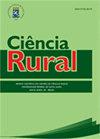Amitraz poisoning in a cat
IF 0.9
4区 农林科学
Q3 AGRONOMY
引用次数: 0
Abstract
ABSTRACT: A 4-month-old male Himalayan cat presented with clinical signs of acute lethargy and motor incoordination after being treated with amitraz for parasite control. On clinical examination, the patient was lethargic and ataxic with severe pulicosis, hypothermia, pale mucous membranes, bradycardia, weak femoral pulses, hyperglycemia, and bilateral mydriasis. Blood tests revealed non-regenerative hypochromic microcytic anemia. Serum alanine levels were elevated tenfold. The patient received supportive treatment with atipamezole (an α2-adrenergic antagonist) at a dose of 0.1 mg/kg intramuscularly. After 24 h of hospitalization and constant monitoring, the patient recovered and was discharged. The published literature showed that the active ingredient amitraz is effective in the treatment of some parasitic diseases in cats, such as scabies and demodicosis; therefore, it is still used for this purpose. Given the small therapeutic margin of this insecticide, veterinarians should caution owners about its potential toxicity. This report emphasized the significance of amitraz intoxication in feline species and the success of the treatment, which should be initiated in the first hour after intoxication.猫的阿米特拉兹中毒
摘要:一只4月龄雄性喜马拉雅猫经阿米特拉兹治疗后出现急性嗜睡和运动不协调的临床症状。临床检查,患者表现为嗜睡和共济失调,伴有严重的骨质疏松、体温过低、粘膜苍白、心动过缓、股脉弱、高血糖和双侧瞳孔肿大。血检显示非再生性低色素小细胞性贫血血清丙氨酸水平升高了10倍。患者给予阿替帕唑(α2-肾上腺素能拮抗剂)0.1 mg/kg肌注支持治疗。住院24 h并持续监测后,患者痊愈出院。已发表的文献表明,活性成分阿米特兹对猫的某些寄生虫病,如疥疮和蠕虫病有效;因此,它仍然用于此目的。鉴于这种杀虫剂的治疗边际很小,兽医应该提醒饲主注意其潜在的毒性。本报告强调了咪唑中毒在猫科动物中的重要性和治疗的成功,应该在中毒后的第一个小时开始治疗。
本文章由计算机程序翻译,如有差异,请以英文原文为准。
求助全文
约1分钟内获得全文
求助全文
来源期刊

Ciencia Rural
AGRONOMY-
CiteScore
1.70
自引率
0.00%
发文量
233
审稿时长
2-4 weeks
期刊介绍:
The purpose of Ciência Rural is to publish the results of original research, note and reviews which contribute significantly to knowledge in Agricultural Sciences. Preference will be given to original articles that develop news concepts or experimental approaches and are not merely repositories of scientific data. The decison of acceptance for publication lies with the Editors and is based on the recommendations of Editorial Comission, Area Committee and/ or ad hoc reviewers. The editors and reviewers are external to the institution.
 求助内容:
求助内容: 应助结果提醒方式:
应助结果提醒方式:


